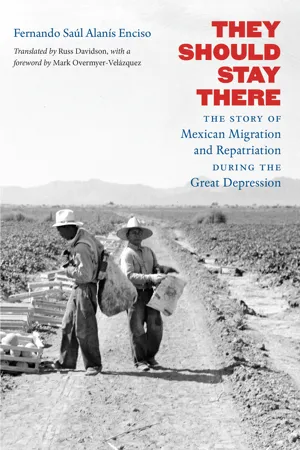
They Should Stay There
The Story of Mexican Migration and Repatriation during the Great Depression
- 272 pages
- English
- ePUB (mobile friendly)
- Available on iOS & Android
They Should Stay There
The Story of Mexican Migration and Repatriation during the Great Depression
About This Book
Here, for the first time in English—and from the Mexican perspective—is the story of Mexican migration to the United States and the astonishing forced repatriation of hundreds of thousands of people to Mexico during the worldwide economic crisis of the Great Depression. While Mexicans were hopeful for economic reform following the Mexican revolution, by the 1930s, large numbers of Mexican nationals had already moved north and were living in the United States in one of the twentieth century's most massive movements of migratory workers. Fernando Saul Alanis Enciso provides an illuminating backstory that demonstrates how fluid and controversial the immigration and labor situation between Mexico and the United States was in the twentieth century and continues to be in the twenty-first. When the Great Depression took hold, the United States stepped up its enforcement of immigration laws and forced more than 350, 000 Mexicans, including their U.S.-born children, to return to their home country. While the Mexican government was fearful of the resulting economic implications, President Lazaro Cardenas fostered the repatriation effort for mostly symbolic reasons relating to domestic politics. In clarifying the repatriation episode through the larger history of Mexican domestic and foreign policy, Alanis connects the dots between the aftermath of the Mexican revolution and the relentless political tumult surrounding today's borderlands immigration issues.
Frequently asked questions
Information
Table of contents
- Cover Page
- Title Page
- Copyright Page
- Dedication
- Contents
- Tables
- Foreword to the English-Language Edition
- Foreword to the Original Edition
- Acknowledgments
- Introduction
- Chapter One: Migratory Movements between Mexico and the United States, 1880–1934
- Chapter Two: The Mexican Community in the United States, 1933–1939
- Chapter Three: The Mexican Government and Repatriation, November 1934–June 1936
- Chapter Four: From the Creation of the Demography and Repatriation Section to the Elaboration of a Repatriation Project, July 1936–October 1938
- Chapter Five: The Repatriation Project, 1938–1939
- Chapter Six: Spanish Refugees, the Repatriated, and the Lower Rio Grande Valley
- Chapter Seven: The 18 March Agricultural Colony in Tamaulipas, 1939–1940
- Chapter Eight: The End of the Project, 1939–1940
- Notes
- Bibliography
- Index